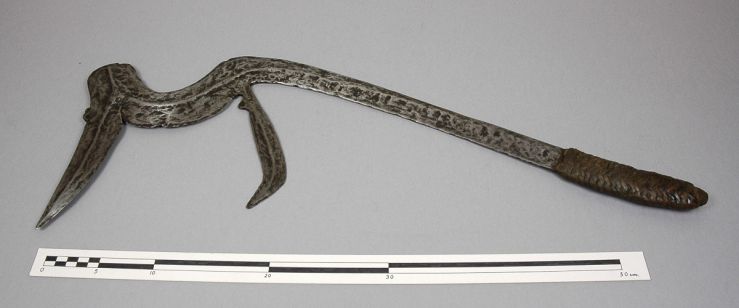Forged in Fire
“Hunga Munga.” S3 Ep6, Sep 27 2016, History Channel.
This is the History Channel’s description of the Hunga Munga:
The term Hunga Munga refers to a variety of Central African throwing knives, all of which feature a series of double-edged iron blades attached to a rawhide handle. The Hunga Munga was not only formidable in hand-to-hand combat, but could be thrown from a distance, with some reports claiming it had a throwing range of up to 250 feet. As armor was not used often in Central Africa, this type of throwing iron was particularly devastating. Hunga Munga was often very valuable, and could be traded for goods. The Hunga Munga was also wielded by Buffy Summers in the cult series “Buffy the Vampire Slayer.”
The first and most fundamental flaw in this description was already identified by the History Channel: the term Hunga Munga is vague and can refer to a number of different knives.
In describing a Teda musri blade from Chad/Sudan in 1922, Henry Balfour (who donated this knife to the Pitt Rivers Museum) wrote: “I have had the knife in question for some 20 years and when sending it to me at that time with other curiosities, my friend in Barbary [coastal region of North Africa] (he is now dead) wrote ‘Shunga Mungha.’ These are scarce and very hard to get. Therefore, this knife must date to the late 19th century or even earlier.” This is the knife being described:

The Pitt Rivers Museum elaborates on the subject: “The modern version of the name is Hunga Munga and is something of a generic European name for all pronged throwing knives. It was used in the American TV series, ‘Buffy the Vampire Slayer,’ to refer to a throwing knife used by the show’s main character” [link].
The History Channel presents a knife similar to the one used by Buffy on television, which is known as bwambwa, and made by the Ngombe and Ngbaka of the D.R. Congo. While consistent with the Buffy’s Hunga Munga, the difference between the bwambwa and the original Shunga Mungha (the musri) is drastic. Indeed, these two distinct cultures were separated by more than 700 miles.

Going back to the History Channel’s description of the Hunga Munga, there are simply too many specific claims being made. For example, “it had a range of up to 250 feet.” What is being described by the term “it”? When using a generic word that could describe any African throwing knife, how can such a specific assertion be made?
“This type of throwing knife was particularly devastating.” Which type?
If the History Channel was interested in focusing on the bwambwa — the knife used in the TV show “Buffy the Vampire Slayer” — they could have described the specifics of its function, flight characteristics, value, and deadliness. But they instead used a generic and meaningless term to describe a specific knife, and then emphasized details that could be true of African throwing knives in general, but not true of the bwambwa.
Compared to the History Channel’s description of a knife “formidable in hand-to-hand combat” that was also a “particularly devastating” as a throwing knife, the truth certainly seems less glamorous:
Ngombe throwing knives took an expert blacksmith several days to produce, and were expensive. While they could be effectively thrown as weapons, their value made such an act impractical; Westerdijk writes, “its owner hurled it only in the last resort, or when he esteemed to have a fair chance of recovering it.” As such, this weapon’s primary role was that of an emblem of power, wealth, and prestige. Known as ngwolo or bwambwa, this weapon type was mainly carried by village heads, lineage elders, and other notables as a symbol of prestige. They were brandished during important funerals, used in initiation ceremonies, and even carried by police during the colonial period (Westerdijk, The African Throwing Knife, 1988).